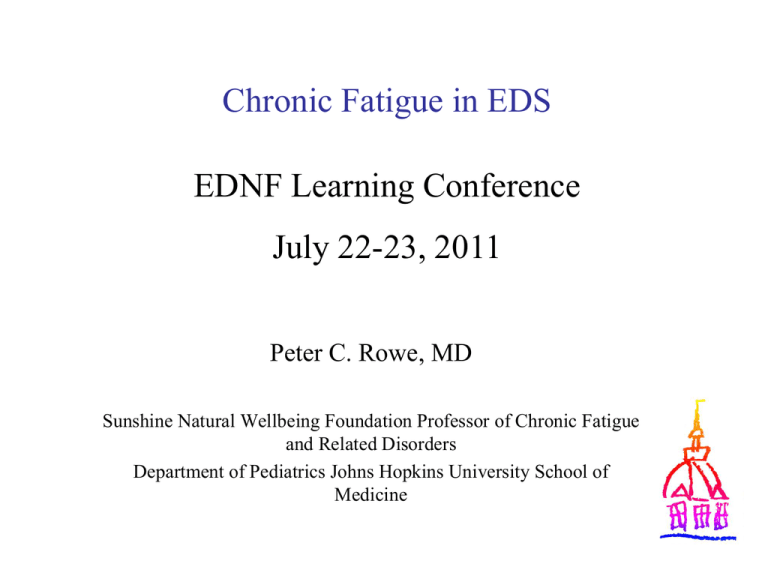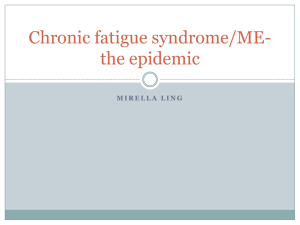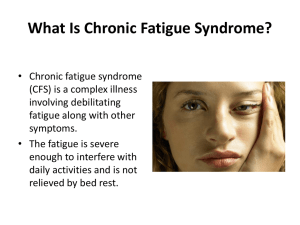Chronic Fatigue In EDS - The Ehlers
advertisement

Chronic Fatigue in EDS EDNF Learning Conference July 22-23, 2011 Peter C. Rowe, MD Sunshine Natural Wellbeing Foundation Professor of Chronic Fatigue and Related Disorders Department of Pediatrics Johns Hopkins University School of Medicine Chronic Fatigue in EDS • • • • Chronic fatigue and CFS definitions Lessons from CFS CF and CFS in EDS Insights of treating chronic fatigue – – – – Treating orthostatic intolerance Non IgE-mediated food protein allergies The paradox of movement restrictions in EDS Ovarian vein varices/pelvic congestion Fatigue An overwhelming sustained sense of exhaustion and decreased capacity for physical and mental work. Piper BF. 1989 Fatigue Definitions • Prolonged fatigue: fatigue lasting 1 – 6 mo. • Chronic fatigue: fatigue lasting > 6 mo. • Chronic fatigue syndrome: new onset fatigue, lasting > 6 mo., unrelieved by rest and 4/8 somatic symptoms From MJA 2002; 176:S17-S55 Symptom Criteria For CFS 4 of 8 needed for diagnosis Fukuda et al. Ann Int Med 1994;121:953-9 • unrefreshing sleep • postexertional malaise lasting > 24 hours • self reported impairment in short-term memory or concentration • sore throat • tender cervical or axillary glands • muscle pain • multijoint pain without swelling • headaches of a new type, pattern, severity CFS Clinical Evaluation Fukuda et al. Ann Int Med 1994;121:953-9 • History, physical, mental status exam • Screening labs: – CBC, ESR/CRP, Chemistries, TSH – Urinalysis – Iron studies, vitamin B12, celiac screening, and, in endemic areas, labs for Lyme and tick-borne infections • Other labs as clinically indicated Chronic Fatigue in EDS • • • • Chronic fatigue and CFS definitions Lessons from CFS CF and CFS in EDS Insights of treating chronic fatigue – – – – Treating orthostatic intolerance Non IgE-mediated food protein allergies The paradox of movement restrictions in EDS Ovarian vein varices/pelvic congestion CFS Epidemiology General Affects previously active individuals Heterogeneous precipitating & perpetuating factors Shift in perception of CFS: No longer considered a single disease More likely a convergence of comorbid pathophysiologic influences CFS Epidemiology Prevalence 4/1,000 adults; 1/1,000 adolescents Age Uncommon under 10 years Peak prevalence 40-49 years Gender 2-4 F : 1 M SES Affects all groups Genetics Twice as common in MZ as DZ twins Associated with EDS Associated with joint hypermobility Research Findings • Acute illness appears to precipitate symptoms in up to 2/3, but evidence of active infection not detected in chronic state (enteroviral infection, Lyme may be exceptions) • Severity of acute infection, not psychological factors, is key determinant of who develops CFS after acute illness • XMRV not an etiologic agent • Immune abnormalities inconsistent & mild • Post-exercise increases in cytokines and genes involved with adrenergic function and pain Light AR et al. J Pain 2009;10:1099 Research Findings • Orthostatic stress and exercise consistently provoke CFS symptoms • All pediatric and most adult studies confirm higher prevalence of orthostatic intolerance • Open treatment of OI leads to improvement in function • CBT and graded exercise provide modest improvement in function but not cure • Low rates of spontaneous improvement for those with > 3 yrs of symptoms Orthostatic Intolerance The term “orthostatic intolerance” refers to a group of clinical conditions in which symptoms worsen with quiet upright posture and are ameliorated (although not necessarily abolished) by recumbency. Modified from: Low PA, Sandroni P, Joyner M, Shen WK. Postural tachycardia syndrome (POTS). J Cardiovasc Electrophysiol 2009;20:352-8. Low PA Rowell LB Human Cardiovascular Control, 1993 Symptoms Of Orthostatic Intolerance Lightheadedness Syncope Diminished concentration Headache Blurred vision Fatigue Exercise intolerance Dyspnea Chest Discomfort Palpitations Tremulousness Anxiety Nausea Nocturia ↑ pooling, ↓ vasoconstriction Orthostatic stress ↓ intra-vascular volume ↑ sympatho-adrenal response NE/Epi NMH NE/Epi POTS Response To Upright Tilt: CFS Abnormal Normal Stage of tilt 1 2 3 CFS CONTROL 16 0 3 1 3 3 1 10 OR for abnormal tilt in those with CFS: 55 (95% CI, 5.4 - 557) Bou-Holaigah, Rowe, Kan, Calkins. JAMA 1995;274:961-7. Response to open treatment of orthostatic intolerance JAMA 1995;274:961-7. CFS And Psychiatry • Many CFS patients have anxiety or depression, but prevalence estimates vary widely depending on the case definition used • Severity usually mild, anhedonia uncommon • Post-exertional malaise more common in CFS • Treating depression and anxiety can improve these symptoms, but usually does not cure CFS 12 wks 24 wks 52 wks White PD et al. PACE trial. Lancet 2011 Chronic Fatigue in EDS • • • • Chronic fatigue and CFS definitions Lessons from CFS CF and CFS in EDS Insights of treating chronic fatigue – – – – Treating orthostatic intolerance Non IgE-mediated food protein allergies The paradox of movement restrictions in EDS Ovarian vein varices/pelvic congestion Classical type EDS: “Fatigue is a frequent complaint.” Beighton P, De Paepe A, Steinmann B, Tsipouras P, Wenstrup R. Ehlers Danlos Syndromes: Revised nosology, Villefranche, 1997 Orthostatic Intolerance CFS EDS/ Joint hypermobility Orthostatic Intolerance And Chronic Fatigue Syndrome Associated With EDS Among approximately 100 adolescents seen in the CFS clinic at JHH over a 1 year period, we identified 12 subjects with EDS 6 classical-type, 6 hypermobile-type EDS 11 female; median age 15 yrs (9-21) NMH in 9/12, POTS in 10/12 Rowe PC, Barron DF, Calkins H, Maumanee IH, Tong PY, Geraghty MT. J Pediatr 1999;135:494-9 Joint Hypermobility In Children With CFS Study question: do children with CFS have a higher prevalence of joint hypermobility? Beighton scores obtained in 58 new & 58 established CFS patients, and in 58 controls Median Beighton scores higher in CFS (4 vs. 1) Beighton score > 4 higher in CFS (60% vs. 24%) Barron DF, Cohen BA, Geraghty MT, Violand R, Rowe PC. J Pediatr 2002;141:421-5 Beighton Joint Hypermobility Scores in 58 Adolescents With CFS And 58 Healthy Controls 35 30 25 20 # Healthy CFS 15 10 5 0 0-1 2-3 4-5 6-7 Beighton scores 8-9 Barron, Geraghty, Cohen, Violand, Rowe. J Pediatr 2002;141:421-5 How might joint hypermobility be associated with OI and CFS? Working hypothesis: Connective tissue laxity in blood vessels allows increased vascular compliance, promotes excessive pooling during upright posture, leading to diminished blood return to the heart, and thus to OI symptoms Rowe PC, et al. J Pediatr 1999;135:494-9 Fatigue is a frequent and clinically relevant problem in EDS (Voermans NC, et al. Semin Arth Rheum 2010; 40:267-74) • 273 patients with EDS • 77% severe fatigue • 57% reported fatigue as 1 of their 3 most important symptoms • Severe fatigue was more common in hypermobile than classical EDS (84% vs. 69%; P=.032) • Fatigue had a greater impact on daily function than did pain Fatigue is a frequent and clinically relevant problem in EDS (Voermans NC, et al. Semin Arth Rheum 2010; 40:267-74) On the basis of their results, the authors speculate about a potential treatment: “A cognitive behavioral intervention focusing on pain, sleep disturbances, the reaction of others to the symptoms, and self-efficacy concerning fatigue could help reduce fatigue and fatigue-related disabilities.” Chronic Fatigue in EDS • • • • Chronic fatigue and CFS definitions Lessons from CFS CF and CFS in EDS Insights of treating chronic fatigue – – – – Treating orthostatic intolerance Non IgE-mediated food protein allergies The paradox of movement restrictions in EDS Ovarian vein varices/pelvic congestion Inhalant allergies/asthma Infection Movement restrictions Migraines Food allergies Anxiety Orthostatic intolerance Chiari type I or c-spine stenosis EDS/JHS Depression Pelvic vein incompetence Chronic fatigue syndrome Treating chronic fatigue 1. Careful history and physical exam, supplemented by questionnaires, to develop working hypotheses about the dominant influences on fatigue 2. Begin working on graded increases in activity, physical therapy if needed 3. Begin treating the dominant influences on symptoms 4. Reassess and repeat steps 1-3 16 year old with fatigue: visit 1 Gastroesophageal reflux and colic in 1st year of life Onset of fatigue and daily lightheadedness at age 13 Develops syncope X 3; Migraines GI: early satiety, reflux, abdo pain, aphthous ulcers O/E: Beighton score 7/9, blue sclerae, easy eyelid eversion, pes planus, papyraceous scar of L knee. Limitations on physical therapy ROM despite joint hypermobility Beck Depression Inventory: dysthymia Visit 1 hypothesis formulation Imp: Plan: EDS OI (already on Florinef) Milk protein intolerance Migraines Movement restrictions Dsythymia Milk-free diet instituted Low dose cyproheptadine Inhalant allergies/asthma Infection Movement restrictions Migraines Food allergies Anxiety Orthostatic intolerance Chiari type I or c-spine stenosis EDS/JHS Depression Pelvic vein incompetence Chronic fatigue syndrome 16 year old with fatigue Visit 2: Plan: Visit 3: Plan: GI symptoms resolved unless he gets inadvertent milk re-exposure; mood more of the problem Low dose Lexapro for mood Mood improved, but still has some orthostatic exacerbation of migraines; still tight on PT exam Add midodrine for OI; begin PT 16 year old with fatigue Visit 4: Plan: Visit 5: Plan: Migraine resolved; better ROM Trial off Lexapro: mood & HA worse, but able to drop to 2.5 mg daily “The more I do, the more I can do” Continue PT Good year, on HS soccer and tennis teams No syncope; migraines only if he does not maintain good hydration No changes. Non-IgE mediated food allergy : 3 cardinal features 1. Recurrent vomiting or GER 2. Recurrent epigastric or abdominal pain 3. Food refusal, picky eating, early satiety Other: aphthous ulcers, unexplained fevers, diarrhea or constipation, headache, myalgias, fatigue, asthma Kelly KJ et al. Gastroenterology 1995;109:1503-12 Non-IgE mediated food allergy • • • • Reaction to suspected food usually delayed 2-6 hrs IgE level, prick skin tests, RAST tests often neg. Eosinophilic esophagitis only the tip of the iceberg Treated with strict avoidance of offending food proteins (milk > soy > egg > wheat); amino acid formulas occasionally needed in infants • Diagnosis supported by clinical response to diet, recurrence of symptoms 2-6 hours after inadvertent dietary challenge, confirmed by DBPCOFC Improvements in esophageal eosinophils after amino acid formula diet Kelly KJ et al. Gastroenterology 1995;109:1503-12 Chronic Fatigue in EDS • • • • Chronic fatigue and CFS definitions Lessons from CFS CF and CFS in EDS Insights of treating chronic fatigue – – – – Treating orthostatic intolerance Non IgE-mediated food protein allergies The paradox of movement restrictions in EDS Ovarian vein varices/pelvic congestion Paradox of movement restrictions in EDS • Increased prevalence of postural abnormalities and movement restrictions among those with CFS • CFS symptoms can be reproduced by selectively placing tension on the neural tissues • Focal movement restrictions are common even in those with generalized joint hypermobility/EDS • Improvement in ROM, orthostatic tolerance, and exercise tolerance can follow manual therapy Abnormal postures Restricted Straight Leg Raise Healthy CFS Symptom Changes with SLR over 12 minutes in Adolescent with CFS Severity 10 9 8 7 6 5 4 3 2 1 0 Fatigue LH Cog Fog Vis Blur 0 10 20 30 40 Degrees of SLR 50 60 0 How Might Movement Restrictions Be Associated With CFS? • Pathophysiology of symptoms with neural elongation strain awaits clarification, but we hypothesize that it contributes to central sensitivity • Informally, improvement in symptoms, ROM, orthostatic tolerance, and exercise tolerance appears to follow manual therapy designed to reduce adverse neural tension and improve movement restrictions Manual Therapy Principles • Use of the hands to restore full, symptomfree mobility within the neuromuscular and articular systems • Goal of treatment is the same as that of exercise-based PT, but manual practitioners treat movement restrictions first before advancing the patient to strenuous activity Manual Techniques • Slow non-thrust manipulations – Sustained stretching – Passive oscillatory movements (neural mobs) – Muscle energy techniques • Gentle indirect techniques – Myofascial release – Strain and counter-strain – Cranio-sacral therapy Chronic Fatigue in EDS • • • • Chronic fatigue and CFS definitions Lessons from CFS CF and CFS in EDS Insights of treating chronic fatigue – – – – Treating orthostatic intolerance Non IgE-mediated food protein allergies The paradox of movement restrictions in EDS Ovarian vein varices/pelvic congestion 16 yr old with EDS, CFS, OI, and 2 yr history of disabling lower back and pelvic pain • Pain worse as the day goes on • Pelvic pain present with urination, when back pain present, with menses • Unable to tolerate sitting in school • Lower abdominal distention as the day goes on • X-rays, scans, MRI of lumbar spine negative • Unresponsive to OCPs, NSAIDs, TENS unit, neurontin, TCA, lumbar support garments, PT, inpatient evaluation Left ovarian vein venogram Catheter in distal L ovarian vein plexus; arrows denote reflux of contrast into internal iliac veins Pre Post Pelvic Congestion Syndrome Venbrux AC, Lambert DL. Curr Opin Ob Gyn 1999; 11:395 • Pelvic heaviness or pain with long periods of standing • Worse at end of the day, during menses • Associated symptoms: fatigue, dyspareunia, bladder urgency • Strong association with varicose ovarian veins • 89% have > 80% relief after embolization of ovarian vein varicosities CFS and ovarian varices: JHH experience • 24 consecutive females with chronic pelvic pain unresponsive to NSAIDs, OCPs, & no other cause identified on Hx, PE, imaging • median age 19, range 16-54 • 16 were < 21 yrs; all but 4 nulliparous • Median duration of pelvic pain 4 yrs (1-15) • All had orthostatic intolerance • 14/24 with EDS Kaushik S, et al. JHH 2003 16 yr old with EDS, CFS, OI, and 2 yr history of disabling lower back and pelvic pain Outcome • Improved symptoms following ovarian and internal iliac embolization • Able to attend school daily • Able to wean midodrine for OI • No further syncope • Wellness score > 90/100 Opportunities for Research 1. What are the risk factors for fatigue in JHS/EDS? 2. What is the prevalence of OI in EDS patients? 3. What is the prevalence of CFS or fibromyalgia symptoms in JHS/EDS? 4. Do therapies directed at OI & related comorbidities in JHS and EDS improve QOL? Treatment of orthostatic intolerance Webinar from September 2010 available on the CFIDS Association of America web site: www.cfids.org Relationship of orthostatic intolerance to chronic fatigue Common Chronic Fatigue Uncommon Low High Tolerance of orthostatic stress Can we move fatigue levels from A to B by treating orthostatic intolerance? Common A Chronic Fatigue B Uncommon Low High Tolerance of orthostatic stress Step 1: Non-pharmacologic measures Where possible, avoid factors that precipitate symptoms Precipitating Factors For OI • Increased pooling/decreased volume Prolonged sitting or standing Warm environment Sodium depletion Prolonged bed rest Varicose veins High carbohydrate meals Diuretics, vasodilators, alpha-blockers Alcohol Precipitating Factors For OI • Increased catecholamines Stress Exercise Pain Hypoglycemia Albuterol Epinephrine Step 1: Non-pharmacologic measures Compression garments – Support hose (waist high > thigh high > knee high) – Body shaper garments – Abdominal binders Step 1: Non-pharmacologic measures Use postural counter-measures • standing with legs crossed • squatting • knee-chest sitting • leaning forward sitting • elevate knees when sitting (foot rest) • clench fists when standing up [Use the muscles as a pump] Step 1: Non-pharmacologic measures Fluids: Minimally 2 L per day Drink at least every 2 hours Need access to fluids at school Avoid sleeping > 12 hrs/day Salt: Increase according to taste Supplement with salt tablets Step 1: Non-pharmacologic measures Exercise Avoid excessive bed rest/sleeping For most impaired, start exercise slowly, increase gradually Recumbent exercise may help at outset Manual forms of PT may be a bridge to better tolerance of exercise “Inactivity is the enemy” [Similar to principles of CBT regarding graded increases in activity] Treatment Of Orthostatic Intolerance • Step 1: non pharmacologic measures • Step 2: treating contributory conditions • Step 3: medications – Monotherapy – Rational polytherapy Inhalant allergies/asthma Infection Movement restrictions Migraines Food allergies Anxiety Orthostatic intolerance Chiari type I or c-spine stenosis EDS/JHS Depression Menstrual pain; ovarian varices Chronic fatigue syndrome Treatment Of Orthostatic Intolerance • Step 1: non pharmacologic measures • Step 2: treating contributory conditions • Step 3: medications – Monotherapy – Rational polytherapy Therapy For Orthostatic Intolerance • blood volume Sodium (PO & occasionally IV), fludrocortisone, clonidine, OCPs • catecholamine release or effect -blockers, disopyramide, SSRIs, ACE inh. • Vasoconstriction Midodrine, dexedrine, methylphenidate, SSRIs, SNRIs, aescin (horse chestnut seed extract) • Misc pyridostigmine bromide ↑ pooling, ↓ vasoconstriction Vasoconstrictors ↓ intra-vascular volume Volume expanders ↑ sympatho-adrenal response Orthostatic stress ↓ NE/Epi NMH Reduce catecholamine release/effect ↑ NE/Epi POTS How to select initial therapy? Algorithm vs. individualized approaches Algorithm approach for POTS from Mayo Clinic investigators Johnson JN, et al. Pediatr Neurology 2010; 42:77-85 Individualized approach • SBP < 110: fludrocortisone, midodrine • Increased HR at baseline or when upright: -blocker Modified from Bloomfield, Am J Cardiol 1999;84:33Q-39Q • Based on other clinical clues Increased salt appetite: fludrocortisone HA: -blocker Dysmenorrhea/worse fatigue with menses: OCP, Depo Anxiety/low mood: SSRI, SNRI Myalgias prominent: SNRI FH of ADHD: stimulant Hypermobility: stimulant, midodrine Management of orthostatic intolerance • requires careful attention by the patient and the practitioner to the factors that provoke symptoms • requires a willingness to try several medications before a good fit is achieved • requires a realization that meds often can treat symptoms but do not necessarily cure OI • management of OI is one part of a comprehensive program of care for patients with other disorders (GI dysautonomia, CFS)







